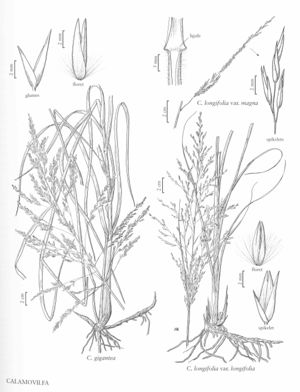Difference between revisions of "Calamovilfa gigantea"
FNA>Volume Importer |
FNA>Volume Importer |
||
| Line 38: | Line 38: | ||
|publication year= | |publication year= | ||
|special status= | |special status= | ||
| − | |source xml=https://jpend@bitbucket.org/aafc-mbb/fna-data-curation.git/src/ | + | |source xml=https://jpend@bitbucket.org/aafc-mbb/fna-data-curation.git/src/f6b125a955440c0872999024f038d74684f65921/coarse_grained_fna_xml/V25/V25_231.xml |
|subfamily=Poaceae subfam. Chloridoideae | |subfamily=Poaceae subfam. Chloridoideae | ||
|tribe=Poaceae tribe Cynodonteae | |tribe=Poaceae tribe Cynodonteae | ||
Revision as of 20:24, 24 September 2019
Rhizomes elongate, covered with shiny, coriaceous, scalelike leaves. Culms to 2.5 m. Sheaths entirely glabrous or pubescent at the throat; ligules 0.7-2 mm; blades to 90 cm long, about 12 mm wide. Panicles 20-80 cm long, 20-60 cm wide; branches to 35 cm, ascending to strongly divergent, lowermost branches sometimes reflexed. Spikelets 7-10.8 mm. Glumes straight; lower glumes 4.5-10.5 mm; upper glumes 6.4-10.1 mm; callus hairs 1/4 - 3/4 as long as the lemma; lemmas 6-10 mm, straight, pubescent, sometimes sparsely so, very rarely glabrous; paleas 6-8.3 mm, pubescent or glabrous; anthers 3-5.5 mm. 2n = 60.
Distribution
Kans., Okla., Colo., N.Mex., Tex., Utah, Nebr., Ariz.
Discussion
Calamovilfa gigantea grows on sand dunes, prairies, river banks, and flood plains in the Rocky Mountains and central plains from Utah and Nebraska to Arizona and Texas.
Selected References
None.
